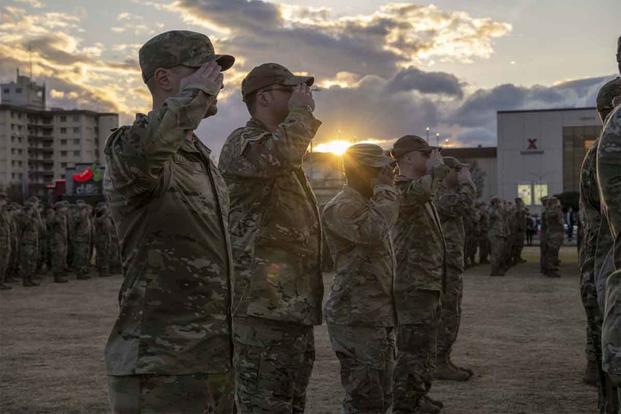
Gabriela Lavoy sat in her Texas home Wednesday morning and thought back to when she spoke to her son days before he died, a phone call in which he revealed he was planning on getting married to his girlfriend and would spend Christmas with his mom for the first time in two years since he was deployed overseas.
But her boy, 33-year-old Tech. Sgt. Zach Emmett Lavoy — an airman with the 1st Special Operations Squadron — never made it home. He, alongside seven other air commandos, died after their CV-22 Osprey crashed off the coast of Japan on Nov. 29 due to a still unpublicized and unspecified mechanical failure that occurred with the controversial tilt-rotor aircraft.
“My son was always hesitant about getting on that plane. He never said he was scared, but he had a feeling, I guess,” Lavoy told Military.com on the phone Wednesday, adding she had not gotten any new information from the Air Force on what went wrong on her son’s training mission.
Read Next: Army Warns Troops to Be Wary of Job Offers as China Wages Subtle Intel-Gathering Campaign
Nearly 2,000 miles away from her home in Texas, lawmakers on a House oversight subcommittee in Washington, D.C., were grilling Navy and Defense Department officials Wednesday, asking about the November crash, as well as why the Osprey has contributed to a staggering 20 service member deaths in the last two years — including three other crashes with the Marine Corps since March 2022.
Family members who lost loved ones in those crashes sat in the front row, holding pictures of their relatives in their laps behind the table of witnesses.
One of those family members was Bart Collart, the father of Cpl. Spencer Collart, a Marine crew chief who died in August after his Osprey went down on the northern coast of Australia, killing him and two others.
The connection between all of those families, especially now, is close. In fact, Collart said that his son Spencer was best friends with another crew member who died in a separate Osprey crash in June 2022, Lance Cpl. Evan Strickland, whose family was also in attendance at the hearing.
“We all sat in the front row to help them feel our presence, let our presence be known,” Collart said. “And I think they got their hands full. The military’s got their hands full with this thing.”
But the Navy and defense officials provided no specific details in response to lawmakers’ questions during the nearly two-hour hearing about the issues with the V-22 program and little clarity for the Gold Star families on what is being done to ensure the safety of the aircraft.
Rep. Glenn Grothman, R-Wis., the chairman of the House Oversight and Accountability Committee’s subcommittee on national security, told those Gold Star family members in attendance that they were due more answers than were given.
“You being here is very important, because I don’t even want to drop this thing today,” Grothman said to the families. He also took aim at the Navy and defense officials, saying, “There were a surprising number of questions that I felt you guys didn’t hear the answers to. … It would have bothered me a lot more if I was one of the folks sitting there behind you.”
When asked by Military.com whether answers from officials were satisfying to him and his family, Collart said, “For the most part, I have to say no,” adding that the subcommittee did a good job holding the witnesses to task, but few revelations were made.
“It was a little disappointing on the little amount of information that we gleaned from the whole thing,” Collart said in an interview. “You want to hear [that] … ‘We’ve done all this research, we found out that these are the problems we need to address, and this is how we plan on addressing those problems.’ … But we got none of that.”
Following the Air Force crash off the coast of Japan in November, the services grounded all versions of the Osprey. Four months later, by March, the services began returning to flight operations but did not disclose the mechanical issue behind the crash.
That same month, the Marine Corps and Navy quickly began returning to the skies. The Air Force, which uses the smallest number of the aircraft for special operations missions, moved more carefully, but as of Wednesday had several of its Ospreys back in the skies.
“As each aircraft is cleared, our aircrew resume flight operations, beginning with basic flights to rebuild crew currency in the aircraft and slowly building in complexity as aircrew fly more,” Lt. Col. Rebecca Heyse, an Air Force Special Operations Command spokesperson, told Military.com on Tuesday.
Heyse said there were “several” of the aircraft flying at Cannon Air Force Base in New Mexico “conducting aircrew currency flights.”
Military.com reported that part of the Osprey Joint Program Office’s guidance for returning to flight operations was that the Air Force, Marine Corps and Navy are barred from flying the aircraft more than 30 minutes away from a landing field in case of an emergency.
Air Force, Navy and Marine Corps officials contacted by Military.com did not answer specific questions about the current restrictions but said they’re following the Joint Program Office’s guidance and are focused on returning the aircraft to their respective missions.
A spokesman for the Osprey program office cited “operational security” as the reason why “procedural risk mitigation controls are not authorized for public release.”
Vice Adm. Carl Chebi, head of Naval Air Systems Command, which oversees the V-22 program for the Air Force, Marine Corps and Navy, said at the hearing that the return-to-flight inspections are still underway for the aircraft and he doesn’t expect it to return to full and unrestricted operations until at least next year.
“I will not certify the V-22 to return to unrestricted flight operations until I am satisfied that we have sufficiently addressed the issues that may affect the safety of the aircraft,” Chebi said. “Based on the data that I have today, I’m expecting that this will not occur before mid-2025.”
Additionally, he added, the clutch system — which Military.com has reported has been a decade-long problem for the aircraft and has been identified as causing a June 2022 crash that led to the death of five Marines in California — is undergoing redesign and testing.
But Rep. Stephen Lynch, D-Mass., told the officials in attendance that if another Osprey crash happens before a clutch redesign, it will likely be the last straw for the V-22 program.
“Your whole program is done, it’s done. If another Osprey goes down, we’re done,” Lynch said. “So, why don’t we ground this now? Ground this now. Don’t allow any other brave Marine or airmen to go down in one of these aircraft.”
The family members of those five Marines who died in a June 2022 Osprey crash, and who last month filed a lawsuit against the manufacturers of the Osprey, provided a long list of questions and concerns they wanted answered about what led to the mechanical failure and what is being done to resolve it.
In a joint statement, they called for quick action to be taken by officials.
“Osprey crews, their families, and the families of those who have been lost deserve to know the cause of these crashes, and what is being done to prevent them in the future,” Timothy Loranger, a Marine veteran and attorney representing the families of the June 2022 Osprey crash in their lawsuit, said in a statement.
Amber Sax, the widow of Marine Corps pilot Capt. John Sax, told Military.com in a phone conversation that she only “got a portion of the story,” referring to the fact that none of the companies who make the major components of the aircraft was present.
“I hope that they do have those people sitting there — I was told it’s possible, so let’s do it,” Sax added.
While some families, like those of the Marines lost in the June 2022 crash in California, have stated “our goal isn’t to see this platform removed,” others grieving the loss of their loved ones are doubtful that any redesigns or changes will make a difference.
“I want the Ospreys to be grounded completely,” Lavoy said, because she doesn’t want any mother to experience the pain she has felt. “I want them to stop using this aircraft altogether.”
Related: Deadly Marine Osprey Crash Triggers Wrongful Death Lawsuit Against Bell Textron, Boeing, Rolls-Royce






